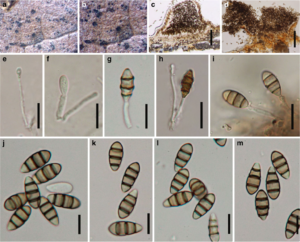Seimatosporium sorbi Wijayaw., Camporesi & K.D. Hyde, in Ariyawansa et al., Fungal Diversity: 10.1007/s13225-015-0346-5, [128] (2015)
Index Fungorum number: IF551181; Facesoffungi number: FoF00669
Etymology − Name after the host genus on which the taxon occurs.
Holotype − MFLU 15-0744
Saprobic on dead branches and stems of Sorbus torminalis L. Sexual morph: Undetermined. Asexual morph: Conidiomata 280–340 μm diam., 180–220 μm high, acervular, unilocular, subglobose, superficial, solitary, dark brown to black, apapillate ostiolate, dehiscent irregular. Conidiomata wall multi-layered, outer 20–30 μm wide, composed of brown, thin-walled cells of textura angularis, inner wall thin, hyaline. Conidiophores 8–20×1.5−3 μm, long, cylindrical, branched, hyaline to sub-hyaline, smooth-walled. Conidiogenous cells holoblastic, annellidic, cylindrical, simple, integrated, determinate, hyaline. Conidia 13–16.5×5.5−
7.5 μm (x = 14.95×6.47 μm, n=20), clavate or obovoid, occasionally truncate base, straight, with 3-septate, septa brown to dark brown, slightly constricted at the septa, eguttulate, pale brown, with hyaline to sub-hyaline basal cell, smooth-walled, lacking appendages. Nag Raj (1993). Farr and Rossman (2015) reported
S. cassiopes (Rostr.) B. Sutton (conidia 18.5−23×7.5− 8.5 μm, fide Sutton 1980) and S. dacicum (Săvul. & Hulea) B. Sutton (conidia 12–15×4–6 μm, fide Sutton 1980) from Sorbus spp. Nevertheless, (Nag Raj 1993) listed both species under unexamined and excluded species. In molecular analyses, our taxon groups with S. vaccinii (Fuckel) B. Erikss. (conidia 13–18.5×4.5−5.5 μm, fide Sutton 1980). Our taxon is morphologically distinct from other species of Seimatosporium (Sutton 1980; Nag Raj 1993) and thus is introduced as a new species.
Culture characteristics: On PDA slow growing, white to light brown from above, pale brown from below, with sparse mycelium, flat, margin uneven, attaining a diam. of 2 cm in 7 days at 18 °C.
Material examined – ITALY, Province of Forlì-Cesena [FC], Fiumicello–Premilcuore, on dead leaf of Sorbus torminalis (Rosaceae), 8 May 2013, Erio Camporesi, IT 1233 (MFLU 15-0744, holotype); Ibid. (HKAS 88745, paratype), living cultures MFLUCC 14-0469, GUCC 65.
Notes – Our collection from Sorbus torminalis morphologically resembles Seimatosporium, and molecular analyses (Fig. 1) showed that it groups with Seimatosporium sensu stricto, hence it is compared with taxa in Sutton (1980) and Nag Raj (1993). Farr and Rossman (2015) reported S. cassiopes (Rostr.) B. Sutton (conidia 18.5−23×7.5− 8.5 μm, fide Sutton 1980) and S. dacicum (Săvul. & Hulea) B. Sutton (conidia 12–15×4–6 μm, fide Sutton 1980) from Sorbus spp. Nevertheless, (Nag Raj 1993) listed both species under unexamined and excluded species. In molecular analyses, our taxon groups with S. vaccinii (Fuckel) B. Erikss. (conidia 13–18.5×4.5−5.5 μm, fide Sutton 1980). Our taxon is morphologically distinct from other species of Seimatosporium (Sutton 1980; Nag Raj 1993) and thus is introduced as a new species.

Fig. 1 Seimatosporium sorbi (holotype) a, b Conidiomata on dead leaf of Sorbus torminalis c, d Cross section of conidiomata e, i Different stages of conidiogenesis j–m Conidia. Scale bars: c, d=150 μm, e–i=10 μm, j–m=5 μm
